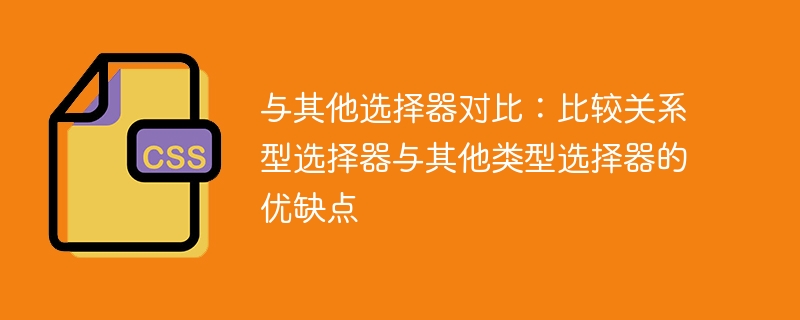Home >Web Front-end >CSS Tutorial >Compared with other selectors: Comparing the advantages and disadvantages - relational selectors and other types of selectors
Compared with other selectors: Comparing the advantages and disadvantages - relational selectors and other types of selectors
- WBOYWBOYWBOYWBOYWBOYWBOYWBOYWBOYWBOYWBOYWBOYWBOYWBOriginal
- 2023-12-26 15:07:06880browse

Comparison with other selectors: Compare the advantages and disadvantages of relational selectors and other types of selectors
Introduction:
In front-end development, selectors are Very important tools, they are used to locate and select elements in HTML documents, and play a key role in style control, event binding and interactive operations on the page. There are many types of selectors, and different selectors are suitable for different scenarios and needs. This article will focus on comparing the advantages and disadvantages of relational selectors and other types of selectors, and give specific code examples.
1. Introduction
Relational selector is a selector that selects based on the relationship between elements. They select elements by describing the relationship between the element and its children, parents, and siblings. Common relational selectors include child selectors, descendant selectors, adjacent sibling selectors and universal sibling selectors. Compared with other types of selectors, relational selectors are more flexible and precise when selecting elements.
2. Sub-selector
The sub-selector selects the sub-elements of the specified element through the ">" symbol, without considering other descendant elements. The advantages of sub-selectors are as follows:
- Precise selection: Sub-selectors only select the direct child elements of the specified element, which can avoid unnecessary selection.
- Performance optimization: The sub-selector can limit the search scope to the children of the specified element, narrowing the search scope and improving the selection speed.
The following is a code example to select all direct child elements under the ul element through the child selector li:
ul > li {
color: red;
}三, Descendant selector
The descendant selector selects the descendant elements of the specified element through the space symbol. No matter how far the descendant elements are, they will be selected. The advantages of the descendant selector are as follows:
- Flexible selection: The descendant selector can select descendant elements at any level, which is very flexible.
- Easy to write: The syntax of the descendant selector is simple and easy to understand, and it is very convenient to write.
The following is a code example to select all p elements in the div element through the descendant selector:
div p {
font-size: 16px;
} 4. Phase Neighboring sibling selector
The adjacent sibling selector selects the next adjacent sibling element of the specified element through the " " symbol. The advantages of the adjacent sibling selector are as follows:
- Independent selection: The adjacent sibling selector only selects a sibling element immediately after the specified element.
- Precise control: The adjacent sibling selector can fine-grained control the style between the specified element and its adjacent sibling elements.
The following is a code example to select the next adjacent sibling elementdiv## of a button element with the "active" class through the adjacent sibling selector. #:
button.active + div {
display: block;
}5. Universal sibling selectorThe universal sibling selector selects all sibling elements of the specified element through the "~" symbol. The advantages of the universal sibling selector are as follows:
- Wide range of selection: The universal sibling selector can select all sibling elements of the specified element, regardless of whether they are before or after the specified element.
- Style sharing: The universal sibling selector can apply styles between multiple sibling elements, share styles, and improve code reusability.
p elements following a span element with the "highlight" class through the universal sibling selector:
span.highlight ~ p {
background-color: yellow;
}Conclusion:Relational selectors select elements by describing the relationship between elements, and have the advantages of flexibility, accuracy and simplicity. The child selector can accurately select the direct child elements of the specified element, the descendant selector can select the descendant elements at any level, the adjacent sibling selector can select the next adjacent sibling element of the specified element, and the universal sibling selector can select the specified element. All brother elements. According to specific needs and scenarios, choosing an appropriate relational selector can better complete development tasks.
The above is the detailed content of Compared with other selectors: Comparing the advantages and disadvantages - relational selectors and other types of selectors. For more information, please follow other related articles on the PHP Chinese website!

